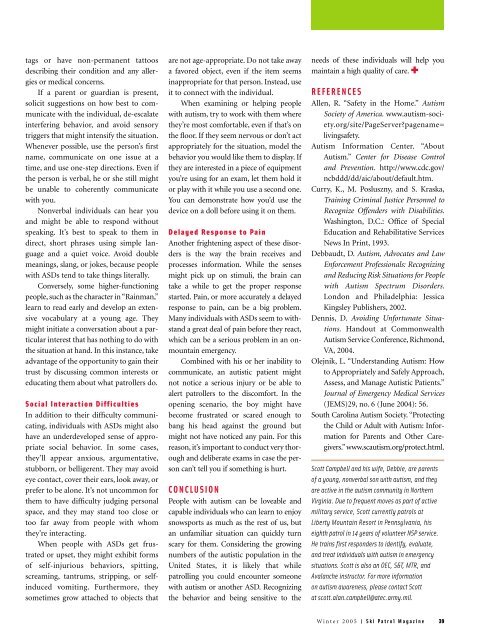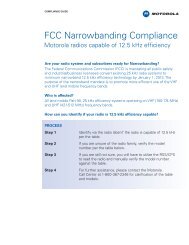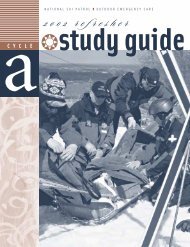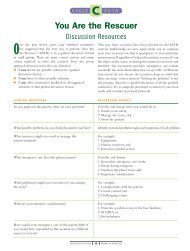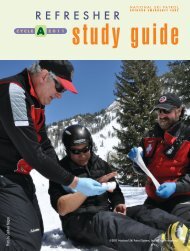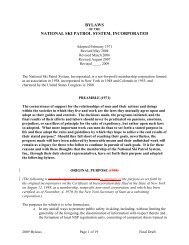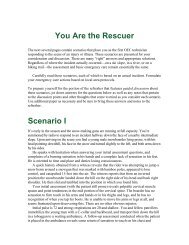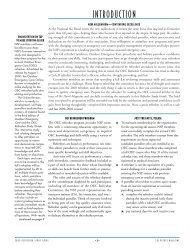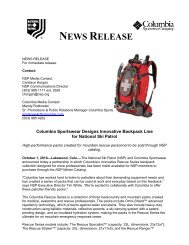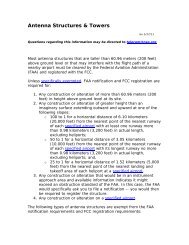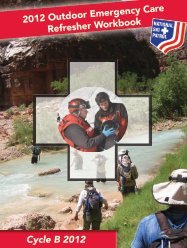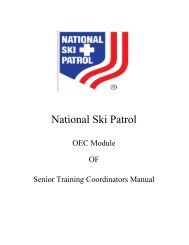Sierra Samaritans - National Ski Patrol
Sierra Samaritans - National Ski Patrol
Sierra Samaritans - National Ski Patrol
You also want an ePaper? Increase the reach of your titles
YUMPU automatically turns print PDFs into web optimized ePapers that Google loves.
tags or have non-permanent tattoos<br />
describing their condition and any allergies<br />
or medical concerns.<br />
If a parent or guardian is present,<br />
solicit suggestions on how best to communicate<br />
with the individual, de-escalate<br />
interfering behavior, and avoid sensory<br />
triggers that might intensify the situation.<br />
Whenever possible, use the person’s first<br />
name, communicate on one issue at a<br />
time, and use one-step directions. Even if<br />
the person is verbal, he or she still might<br />
be unable to coherently communicate<br />
with you.<br />
Nonverbal individuals can hear you<br />
and might be able to respond without<br />
speaking. It’s best to speak to them in<br />
direct, short phrases using simple language<br />
and a quiet voice. Avoid double<br />
meanings, slang, or jokes, because people<br />
with ASDs tend to take things literally.<br />
Conversely, some higher-functioning<br />
people, such as the character in “Rainman,”<br />
learn to read early and develop an extensive<br />
vocabulary at a young age. They<br />
might initiate a conversation about a particular<br />
interest that has nothing to do with<br />
the situation at hand. In this instance, take<br />
advantage of the opportunity to gain their<br />
trust by discussing common interests or<br />
educating them about what patrollers do.<br />
Social Interaction Difficulties<br />
In addition to their difficulty communicating,<br />
individuals with ASDs might also<br />
have an underdeveloped sense of appropriate<br />
social behavior. In some cases,<br />
they’ll appear anxious, argumentative,<br />
stubborn, or belligerent. They may avoid<br />
eye contact, cover their ears, look away, or<br />
prefer to be alone. It’s not uncommon for<br />
them to have difficulty judging personal<br />
space, and they may stand too close or<br />
too far away from people with whom<br />
they’re interacting.<br />
When people with ASDs get frustrated<br />
or upset, they might exhibit forms<br />
of self-injurious behaviors, spitting,<br />
screaming, tantrums, stripping, or selfinduced<br />
vomiting. Furthermore, they<br />
sometimes grow attached to objects that<br />
are not age-appropriate. Do not take away<br />
a favored object, even if the item seems<br />
inappropriate for that person. Instead, use<br />
it to connect with the individual.<br />
When examining or helping people<br />
with autism, try to work with them where<br />
they’re most comfortable, even if that’s on<br />
the floor. If they seem nervous or don’t act<br />
appropriately for the situation, model the<br />
behavior you would like them to display. If<br />
they are interested in a piece of equipment<br />
you’re using for an exam, let them hold it<br />
or play with it while you use a second one.<br />
You can demonstrate how you’d use the<br />
device on a doll before using it on them.<br />
Delayed Response to Pain<br />
Another frightening aspect of these disorders<br />
is the way the brain receives and<br />
processes information. While the senses<br />
might pick up on stimuli, the brain can<br />
take a while to get the proper response<br />
started. Pain, or more accurately a delayed<br />
response to pain, can be a big problem.<br />
Many individuals with ASDs seem to withstand<br />
a great deal of pain before they react,<br />
which can be a serious problem in an onmountain<br />
emergency.<br />
Combined with his or her inability to<br />
communicate, an autistic patient might<br />
not notice a serious injury or be able to<br />
alert patrollers to the discomfort. In the<br />
opening scenario, the boy might have<br />
become frustrated or scared enough to<br />
bang his head against the ground but<br />
might not have noticed any pain. For this<br />
reason, it’s important to conduct very thorough<br />
and deliberate exams in case the person<br />
can’t tell you if something is hurt.<br />
CONCLUSION<br />
People with autism can be loveable and<br />
capable individuals who can learn to enjoy<br />
snowsports as much as the rest of us, but<br />
an unfamiliar situation can quickly turn<br />
scary for them. Considering the growing<br />
numbers of the autistic population in the<br />
United States, it is likely that while<br />
patrolling you could encounter someone<br />
with autism or another ASD. Recognizing<br />
the behavior and being sensitive to the<br />
needs of these individuals will help you<br />
maintain a high quality of care. ✚<br />
REFERENCES<br />
Allen, R. “Safety in the Home.” Autism<br />
Society of America. www.autism-society.org/site/PageServer?pagename=<br />
livingsafety.<br />
Autism Information Center. “About<br />
Autism.” Center for Disease Control<br />
and Prevention. http://www.cdc.gov/<br />
ncbddd/dd/aic/about/default.htm.<br />
Curry, K., M. Posluszny, and S. Kraska,<br />
Training Criminal Justice Personnel to<br />
Recognize Offenders with Disabilities.<br />
Washington, D.C.: Office of Special<br />
Education and Rehabilitative Services<br />
News In Print, 1993.<br />
Debbaudt, D. Autism, Advocates and Law<br />
Enforcement Professionals: Recognizing<br />
and Reducing Risk Situations for People<br />
with Autism Spectrum Disorders.<br />
London and Philadelphia: Jessica<br />
Kingsley Publishers, 2002.<br />
Dennis, D. Avoiding Unfortunate Situations.<br />
Handout at Commonwealth<br />
Autism Service Conference, Richmond,<br />
VA, 2004.<br />
Olejnik, L. “Understanding Autism: How<br />
to Appropriately and Safely Approach,<br />
Assess, and Manage Autistic Patients.”<br />
Journal of Emergency Medical Services<br />
(JEMS)29, no. 6 (June 2004): 56.<br />
South Carolina Autism Society. “Protecting<br />
the Child or Adult with Autism: Information<br />
for Parents and Other Caregivers.”www.scautism.org/protect.html.<br />
Scott Campbell and his wife, Debbie, are parents<br />
of a young, nonverbal son with autism, and they<br />
are active in the autism community in Northern<br />
Virginia. Due to frequent moves as part of active<br />
military service, Scott currently patrols at<br />
Liberty Mountain Resort in Pennsylvania, his<br />
eighth patrol in 14 years of volunteer NSP service.<br />
He trains first responders to identify, evaluate,<br />
and treat individuals with autism in emergency<br />
situations. Scott is also an OEC, S&T, MTR, and<br />
Avalanche instructor. For more information<br />
on autism awareness, please contact Scott<br />
at scott.alan.campbell@atec.army.mil.<br />
W inte r 2005 | <strong>Ski</strong> <strong>Patrol</strong> Magazine 39


